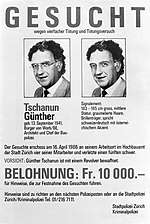Zürich HB SZU railway station
Altstadt (Zürich)Railway stations in Switzerland opened in 1990Railway stations in ZürichRailway stations located undergroundSihl ... and 1 more
Sihltal Zürich Uetliberg Bahn stations

Zürich HB SZU railway station (German: Bahnhof Zürich HB SZU) is a railway station in the municipality of Zürich, in the Swiss canton of Zürich. It is underneath and physically connected to the Zürich Hauptbahnhof, Zürich's primary train station, although they do not share any tracks. The station is the terminus of the standard gauge Sihltal and Uetliberg railway lines of the Sihltal Zürich Uetliberg Bahn. The station opened on 5 May 1990, following the completion of a new tunnel under the Sihl from the old terminus at Zürich Selnau.
Excerpt from the Wikipedia article Zürich HB SZU railway station (License: CC BY-SA 3.0, Authors, Images).Zürich HB SZU railway station
Bahnhofpassage, Zurich Altstadt
Geographical coordinates (GPS) Address Nearby Places Show on map
Geographical coordinates (GPS)
| Latitude | Longitude |
|---|---|
| N 47.376944444444 ° | E 8.5388888888889 ° |
Address
Bahnhofpassage
8090 Zurich, Altstadt
Zurich, Switzerland
Open on Google Maps









